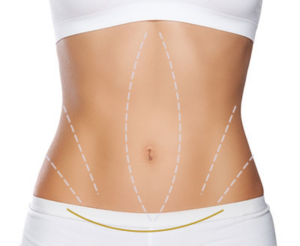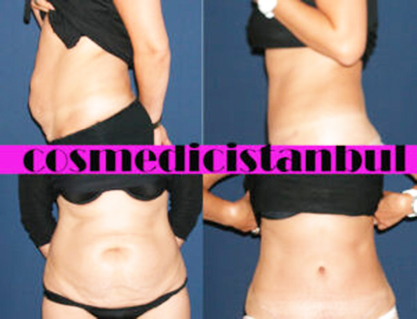Tummy tuck

Body shape problems on the stomach, the thighs or the upper arms are in some people, neither by diet nor exercise, massage or liposuction to fix. Excess skin and fatty tissue masses can then be corrected by plastic surgery such as a skin tightening in each area. Mostly it is the lower abdomen, which no longer fits the aesthetic overall impression of the body proportions. Here a tummy tuck can be made. Often it is also the thighs, the inside show excessive fatty tissue and skin folds, or even the loose skin of the upper arms, which has lost its elasticity and does not regress. In these cases, a thigh lift or upper arm tightening can be performed. In individual cases, the changes are so pronounced that they are also to be regarded as illness. This is especially true for chronic skin irritation, movement disorders or abdominal wall problems.
Bear in mind
What happens with a skin tightening actually?
Excessive and sagging skin and adipose tissue are accurately measured and surgically removed. The necessary steps are performed in such a way that the least possible conspicuous scar formation results. In addition, the aesthetic body contour in the procedure can be improved by targeted liposuction of adjacent areas.
What results can be achieved by tightening the skin?
With the surgical skin and fat removal (Dermolipektomie): Although larger skin incisions and longer scars must be accepted, but it can also be removed large fat aprons and skin wrinkles, for which there are no other correction options. After the operation, not only the body proportions are harmoniously restored, but also the sporting activity and the subjective well-being receive a new upswing.
Anesthesia form and hospital stay
General anesthesia and inpatient hospitalization are usually required for skin tightening that is between three and ten days, depending on the extent of the operated area. Only small skin tightening can occasionally be done in local anesthesia and on an outpatient basis.
How do I prepare for the operation?
Prior to surgical skin and fat removal, all other options for weight loss should be exhausted. The closer you are to your ideal weight, the better the surgical result. Your skin can protect you from the operation by special care and stimulate the blood circulation by cold showering. In large operations, it may make sense to donate your own blood, which must be taken three to six weeks before surgery in our hospitals. You should not take any analgesics (such as aspirin) for 14 days before the operation because they delay the blood clotting process. Alcohol, sleeping pills and nicotine should be avoided. For extreme amounts of adipose tissue, donating your own blood four weeks before the surgery can help your safety and the healing process.

How is the operation going?
Even before the anesthesiologist initiates the anesthesia, the areas to be removed are measured and marked. The skin is then disinfected several times for surgical preparation. Vascular-active solutions can greatly reduce bleeding during surgery. Excess skin and underlying fatty tissue are removed. Occasionally, this can be assisted by liposuction. Simultaneously with the suturing of the wound edges, the remaining skin is tightened. To prevent bruises or wound secretions, vacuum tubes (redondrainages) are placed for one to three days. Even under general anesthesia, the dressing is applied. Tummy tucks often remove the entire skin between the navel and pubic mound and tighten the straight abdominal muscles in the midline to regain optimal contour. Then the navel has to be re-sewn into the tightened skin. With a thigh lift on the inside of the thighs, we distinguish the “small” horizontal tightening with a seam between the groin and seat leg from the “big” vertical tightening, where the seam runs from the groin to the inside of the knee. In the case of upper arm tightening, the suture is always guided on the inside from the armpit to the elbow. Excess skin and fat deposits can also be removed on other parts of the body. The cut is coordinated individually with you.
What happens after the operation?
Immediately after surgery, you will need painkillers that will give you the necessary rest and relaxation to heal. Thrombosis stockings are applied against blood clots and embolisms or preventive agents are also administered. Through isometric muscle exercises, which we are happy to show you, you can stimulate blood circulation and oxygenation. The wound healing of the skin and the disappearance of the swelling takes about ten to 14 days. However, the final healing is only expected after several weeks.

Which risks have to be considered?
If you suffer from vascular disease, venous stasis or blood clots (thrombosis, fat embolism), special precautions should be taken with your doctor. Allergies to medications, patches or ointments should be reported to us in any case, as well as other diseases and regular medication. Before the operation your blood picture and the blood coagulation, before anesthesia also the EKG (heart) and the lung are examined.

What complications can arise?
Because they are larger wound areas, bruising and secretions or bacterial infections can interfere with healing. Skin sensation and lymph drainage regenerate slowly over several months and can be reduced in the scar area. Greater blood loss must be compensated by infusions and possibly blood transfusions. Thrombosis and embolism are extremely rare, but could lead to the threat of circulation and respiration. Noticeable scars after disturbed wound healing can usually be improved by minor corrective surgery under local anesthesia.
Which after treatment is required?
The healing is to be supported by a skin care and by light compression with support tights or bodys. These should be worn for six weeks during the day. With cold showers you can stimulate blood circulation and support healing. Absorbable skin sutures dissolve themselves, other sutures are removed after about 1 weeks. You will be informed about further measures for your individual follow-up treatment before the hospital discharge.
Free Consultation

